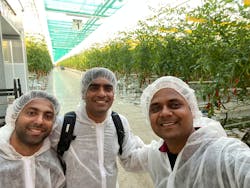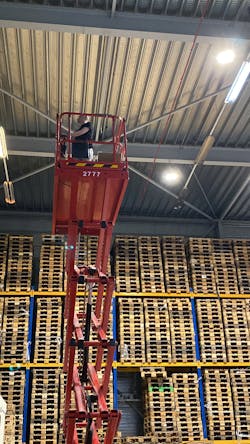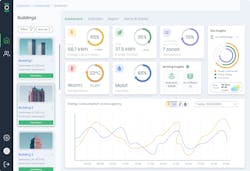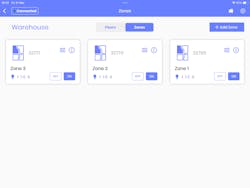EDITED BY CARRIE MEADOWS
Three years ago, Sharan Avati, Sanu Davis, and Vinay Hiremath combined their experience and skill sets in wireless technology, product development, and business development to found Cosmicnode, a firm dedicated to providing reliable, low-latency, and scalable wireless lighting controls for smart building and horticulture automation.
Along with a bachelor's degree in electronics and communication, founder and CEO Avati brings more than 15 years of expertise in the field of wireless mesh technology, which led to Cosmicnode's foundational wireless mesh platform. Co-founder Davis has a bachelor's in electrical and electronics engineering and 15-plus years of experience in product development and quality assurance in the building automation and lighting industry. And Hiremath, who holds an MBA in sales and marketing, brings 15-plus years of experience in business development and customer engagement to the team.
Since starting in an attic in 2020, Cosmicnode has transformed into a fast-growing startup headquartered at the High Tech Campus in Eindhoven, the Netherlands, and received funding in 2022 from Limburg, Netherlands–based venture capital firm LIOF. Currently, a team of 25 “Cosmics” is spread across the Netherlands, Germany, U.K., and India.
Firm mission: Our mission is to unlock the extraordinary potential of multiradio wireless mesh controls for a better world. We are driving innovation and technology by transforming buildings and greenhouses globally with the help of a data-driven IoT platform. Our wireless lighting solution enables OEMs, lighting manufacturers, integrators, and installers to incorporate reliable and robust wireless lighting controls technology into their product ecosystem.
What we are known for: Our low-latency wireless lighting controls that support smart building automation and horticultural lighting as they scale to larger enterprises. We are leading the way to a smarter future with wireless controls for buildings, space, and light management.
First commission: In just three years, we have already made good on our aim to provide automation for a more sustainable future. We deployed our first wireless mesh controls system in the horticulture industry in summer 2020 in the Netherlands. The system comprises 2,400 nodes with wireless plug-and-play controllers, an IoT gateway, a Modbus gateway integrated with a climate computer, and on-premises spectrum controls application.
Industry generalization or perception that should be debunked: We are challenging the industry myth that wireless solutions cannot be reliable and scalable. We have debunked this by successfully deploying more than 100,000 wireless nodes in greenhouses and buildings globally.
Top industry concern today: That current wireless systems are not interoperable; they are not flexible for third-party integration; and there is a lack of standardization.
Yet in record time, we have achieved wireless control of more than 10,000 grow lights in a single network. Cosmicnode is integrated with all the leading climate computer companies in the world using our proprietary simple and flexible Modbus protocol. Its robust wireless multiradio platform, with scalability for up to tens of thousands of nodes and the flexibility to provide dynamic zoning of lamps and sensors, is one advance over existing products.
Another is its multiradio mesh system, which helps extend the range and bandwidth beyond what is customary for wireless controls, operating without interference in a dense network and enabling large amounts of data to be collected.
What are you currently working on? We are developing our new Infinity IoT platform that provides robust, highly scalable, and reliable multiradio wireless lighting controls for commercial and industrial applications.
It can transform buildings by fulfilling light management, occupancy management, asset tracking, and environmental analytics for applications including commercial offices, industrial, retail, parking, street lighting, public spaces, and sports stadiums.
This approach to building automation has the ability to significantly reduce energy consumption and increase operational efficiency, with the continued push toward lower carbon emissions and a net-zero world. Our controls and automation solutions reflect the value of our brand culture — customer first, innovation, ownership, and integrity.
Technology, product, or designer you admire: The interoperability between lighting and controls has been showcased by DALI, the internationally standardized protocol for digital communication between lighting control devices, and Zhaga, an industrywide consortium aiming to standardize specifications for interfaces between LED luminaires and light engines.
These innovations will prove fundamental to furthering and future-proofing an ecosystem of lighting hardware and controls that can support modularity, product upgrades, and a greater variety of components that communicate properly with one another.
What should the lighting and controls industry talk more about? One of the ways that the lighting and controls sectors can join together to benefit the industry is through truly using light as a digital data point. Lighting comprises a large portion of a building’s infrastructure — it is required in all buildings and with placement throughout the entire space.
This existing ubiquitous infrastructure can provide the backbone for value-added services such as occupancy management, space management, asset tracking, and building analytics that support facility return on investment by reducing operating expenses and delivering real-time information for security, health, and resource management.
Advice to anyone interested in developing controls technology or entering the industry: It is a poignant time for emerging and up-and-coming developers interested in entering the controls technology space. The market for these products is growing and evolving, presenting new opportunities as the awareness of lighting controls increases and the benefits of wireless technologies in the controls industry are showcased.
CARRIE MEADOWS is managing editor of LEDs Magazine, with 20-plus years’ experience in business-to-business publishing across technology markets including solid-state technology manufacturing, fiberoptic communications, machine vision, lasers and photonics, and LEDs and lighting.
Follow our LinkedIn page for our latest news updates, contributed articles, and commentary, and our Facebook page for events announcements and more. You can also find us on Twitter.

Carrie Meadows | Editor-in-Chief, LEDs Magazine
Carrie Meadows has more than 20 years of experience in the publishing and media industry. She worked with the PennWell Technology Group for more than 17 years, having been part of the editorial staff at Solid State Technology, Microlithography World, Lightwave, Portable Design, CleanRooms, Laser Focus World, and Vision Systems Design before the group was acquired by current parent company Endeavor Business Media.
Meadows has received finalist recognition for LEDs Magazine in the FOLIO Eddie Awards, and has volunteered as a judge on several B2B editorial awards committees. She received a BA in English literature from Saint Anselm College, and earned thesis honors in the college's Geisel Library. Without the patience to sit down and write a book of her own, she has gladly undertaken the role of editor for the writings of friends and family.
Meadows enjoys living in the beautiful but sometimes unpredictable four seasons of the New England region, volunteering with an animal shelter, reading (of course), and walking with friends and extended "dog family" in her spare time.









